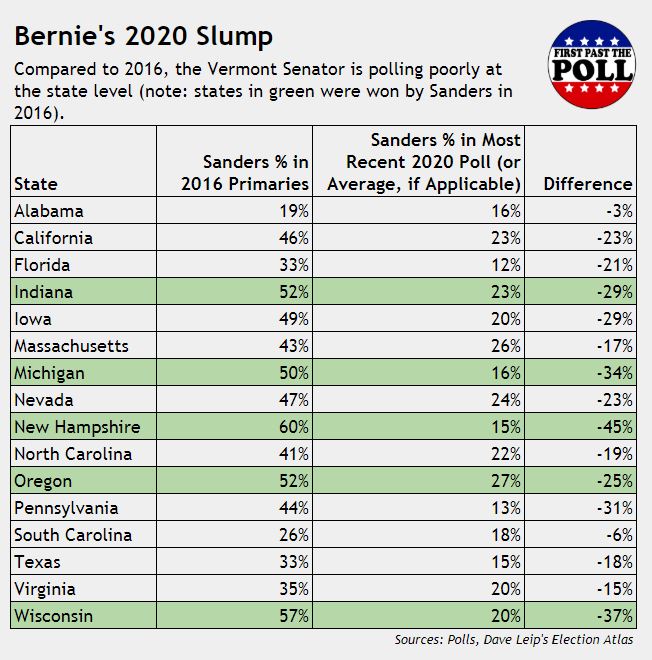Upon launching his second presidential campaign, Vermont Senator Bernie Sanders promised to change his strategy for 2020. And in some ways, he has — hoping to win over a broader coalition of voters, he embarked on an ambitious trip across the Deep South and has taken steps to increase the diversity of his staff.
Yet at the same time, Sanders maintains the same firebrand-like personality and platform that gained him such a large following in the first place. For this reason, his 2020 campaign has been dubbed a second-take of his 2016 bid.
Except there’s one major difference: he isn’t doing nearly as well now as he did then.
Perhaps the easiest place to see this is nationally. By the time the 2016 Democratic primaries wrapped up, Sanders had courted 4-in-10 primary voters, dominated 11 of the 13 caucuses, and walked away with about 34% of the available delegates.
With such promising results, it wouldn’t be farfetched to assume that he’s commanding today’s field of Democrats. Unfortunately for Sanders, though, this isn’t the case. RealClearPolitics currently pegs him averaging 17 percentage points nationwide, a distant second behind Joe Biden and a far cry from the 42% he finished with three years ago.
When it comes to the states, things aren’t looking much better for Sanders, either.

As the above chart demonstrates, compared to how he did in the 2016 primaries, Sanders is underperforming in every state polled. Notably, he’s seen some of the steepest drop-offs in Iowa and New Hampshire, both of which are key early contests (as you may recall, Sanders nearly beat Hillary Clinton in the most recent Iowa caucus and soundly defeated her in New Hampshire the following week).
The story doesn’t sound much better in states Sanders carried the last time around — alongside polling second in New Hampshire, he trails Joe Biden in Indiana, Michigan, and Wisconsin, and is locked in a statistical tie in Oregon. Additionally, based on souring numbers in North and South Carolina, his efforts to appeal to African American voters don’t seem to be bearing much fruit.
To be clear, caveats abound: as I’ve said on this blog numerous times, it’s still early in the election cycle, meaning these numbers could swing substantially (remember that Sanders was only polling at around 10% in June 2015); state-level primary polls also don’t have the best track record, and many of the surveys cited come from Change Research and Emerson College, neither of which are renowned for their methodologies.
Nevertheless, there’s no denying that Sanders is doing worse in 2020 than he did 2016, especially given the brand construction and name recognition advantages he had heading into the race.
So, what happened?
One of the most popular theories explaining Sanders’s disappointing start is that his supporters are jumping ship for Elizabeth Warren, who holds similar ideological ideals while also potentially appealing to a broader electorate. Indeed, in recent weeks, Warren has attempted to cut into the Vermont Senator’s working class base in the Midwest.
But that idea isn’t fully reflected in polling. For instance, Morning Consult’s most recent survey suggests that 19% of Sanders supporters consider Warren their second choice, and 21% of Warren supporters consider Sanders their second choice. Warren has also performed better among highly educated voters and those who are paying a lot of attention to the campaign. In short, while Warren definitely swayed some Sanders supporters, the candidates’ bases don’t fully overlap.
Instead, former Sanders backers are probably being pulled in a number of directions. After all, more candidates (a whopping two-dozen!) mean more options.
It’s estimated that around 25% of his base in the 2016 primaries came from a “Never Hillary” coalition. With that in mind, it’s likely that a sizable portion of Sanders voters backed him not because of who he was, but because of who he wasn’t. With Clinton out of the race — and other palatable politicians in it — Sanders is having a hard time returning to his 2016 numbers.
But no matter what accounts for this decline, one thing is clear: though his path to the nomination is easy to envision, Sanders is in a rougher spot than hoped. As a result, these next few months will be crucial to seeing if he can climb to the top.

